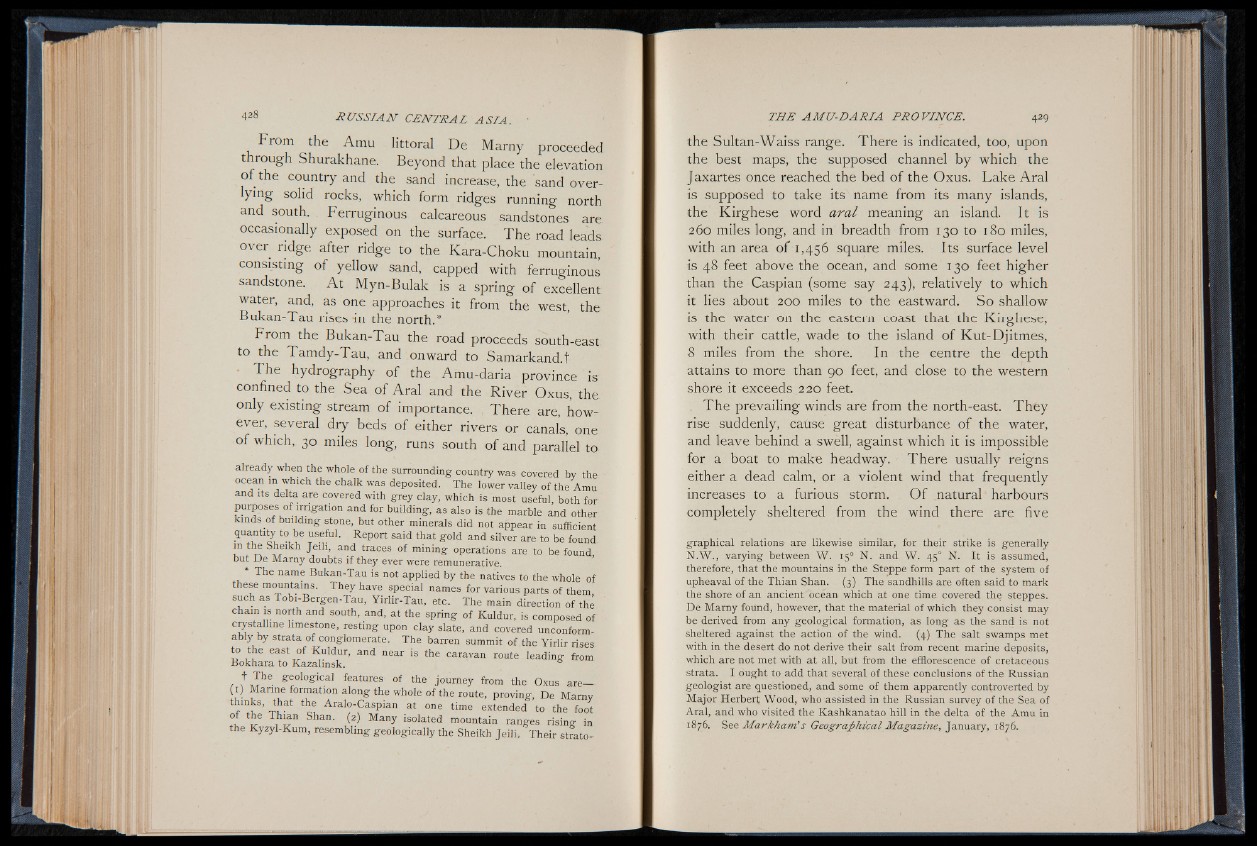
From the Amu littoral De Marny proceeded
through Shurakhane. Beyond that place the elevation
of the country and the sand increase, the sand over-
lying solid rocks, which form ridges running north
and south. Ferruginous calcareous sandstones are
occasionally exposed on the surface. The road leads-
over ridge after ridge to the Kara-Choku mountain,
consisting of yellow sand, capped with ferruginous
sandstone. A t Myn-Bulak is a spring of excellent:
water, and, as one approaches it from the west, the
Bukan-Tau rises in the north.*
From the Bukan-Tau the road proceeds south-east
to the Tamdy-Tau, and onward to Samarkand, t
The hydrography of the Amu-daria province is
confined to the Sea of Aral and the River Oxus, the
only existing stream of importance. , There are, however,
several dry beds of either rivers or canals, one
of which, 30 miles long, runs south of and parallel to
already when the whole of the surrounding- country was covered by the
ocean m which the chalk was deposited. The lower valley of the Amu
and its delta are covered with grey clay, which is most useful, both for
purposes of irrigation and for building, as also is the marble and other
kinds of building stone, but other minerals did not appear in sufficient
quantity to be useful. Report said that gold and silver are to be found,
m the Sheikh Jeili, and traces of mining operations are to be found
but De Marny doubts if they ever were remunerative.
The name Bukan-Tau is not applied by the natives to the whole of
these mountains. They have special names for various parts of them
such as Tobi-Bergen-Tau, Yirlir-Tau, etc. The main direction of thé
chain is north and south, and, at the spring of Kuldur, is composed o f
crystalline limestone, resting upon clay slate, and covered unconform-
ably by strata of conglomerate. The barren summit of the Yirlir rises,
to the east of Kuldur, and near is the caravan route leading from
Bokhara to Kazalinsk.
\ S'®olo£ical features of the journey from the Oxus are—
(1) Marine formation along the whole of the route, proving De Mamv
t f 1Î S’ ‘ hat Aralo"CasPian at °ne time extended to the foot
o f the Thian Shan. (2) Many isolated mountain ranges rising in
the Kyzyl-Kum, resembling geologically the Sheikh Jeili, Their stratothe
Sultan-Waiss range. There is indicated, too, upon
the best maps, the supposed channel by which the
Jaxartes once reached the bed of the Oxus. Lake Aral
is supposed to take its name from its many islands,
the Kirghese word aral meaning an island. It is
260 miles long, and in breadth from 130 to 180 miles,
with an area of 1,456 square miles. Its surface level
is 48 feet above the ocean, and some 130 feet higher
than the Caspian (some say 243), relatively to which
it lies about 200 miles to the eastward. So shallow
is the water on the eastern coast that the Kirghese,
with their cattle, wade to the island of Kut-Djitmes,
8 miles from the shore. In the centre the depth
attains to more than 90 feet, and close to the western
shore it exceeds 220 feet.
The prevailing winds are from the north-east. They
rise suddenly, cause great disturbance of the water,
and leave behind a swell, against which it is impossible
for a boat to make headway. There usually reigns
either a dead calm, or a violent wind that frequently
increases to a furious storm. O f natural harbours
completely sheltered from the wind there are five
graphical relations- are likewise similar, for their strike is generally
N .W ., varying between W . 150 N. and W. 45° N. It is assumed,
therefore, that the mountains in the Steppe form part of the system of
upheaval of the Thian Shan. (3) The sandhills are often said to mark
the shore of an ancient'ocean which at one time covered the steppes.
De Marny fohnd, however, that the material of which they consist may
be derived from any geological formation, as long as the sand is not
sheltered against the action of the wind. (4) The salt swamps met
with in the desert do not derive their salt from recent marine deposits,
which are not met with at all, but from the efflorescence of cretaceous
strata. I ought to add that several, of these conclusions of the Russian
geologist are questioned, and some of them apparently controverted by
Major Herbert Wood, who assisted in the Russian survey of the Sea of
Aral, and who visited the Kashkanatao hill in the delta of the Amu in
1876. See Markham's Geographical Magazine, January, 1876.